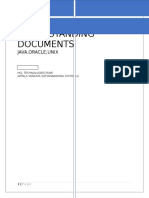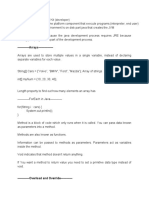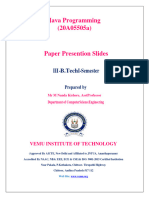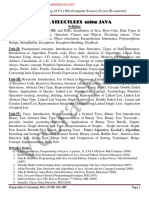0% found this document useful (0 votes)
32 views4 pagesJava OOP and Collections Guide
The document discusses various Java concepts including methods, method overloading, overriding, OOP, classes, attributes, constructors, modifiers, encapsulation, inheritance, polymorphism, abstraction, interfaces, collections, lists, array lists, linked lists, iterators, sets, hash sets, queues, maps, hash maps.
Uploaded by
gunaCopyright
© © All Rights Reserved
We take content rights seriously. If you suspect this is your content, claim it here.
Available Formats
Download as PDF, TXT or read online on Scribd
0% found this document useful (0 votes)
32 views4 pagesJava OOP and Collections Guide
The document discusses various Java concepts including methods, method overloading, overriding, OOP, classes, attributes, constructors, modifiers, encapsulation, inheritance, polymorphism, abstraction, interfaces, collections, lists, array lists, linked lists, iterators, sets, hash sets, queues, maps, hash maps.
Uploaded by
gunaCopyright
© © All Rights Reserved
We take content rights seriously. If you suspect this is your content, claim it here.
Available Formats
Download as PDF, TXT or read online on Scribd
/ 4
























































